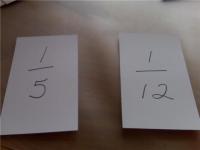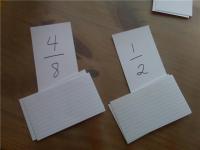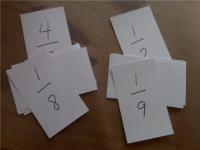Simple Saturday: A Fraction War
Fractions can be deadly...well, tricky anyway. Just think about all of the wacky rules involved in computing with them entail. The larger the denominator the smaller fraction. Two fractions with completely different numerators and denominators can be equal. Now, how the heck can that be true? Don't even begin to talk about reciprocals or improper fractions. And then, on top of all of this, we have to reduce these babies? Fractions aren't playing fair, and that's all there is to it.
 Years ago I worked at a school for at-risk high-schoolers, I loved that job. I clearly remember sitting beside with an ex-gang member with a tear-drop tatooed at the corner of his eye and the words 'love' and 'hate' tattooed on the flesh between his scarred knuckles and finger joints. As I presented the notion of reciprocal fractions, I noticed the hand clenching his pencil wasn't not the one with 'love' printed on it.
Years ago I worked at a school for at-risk high-schoolers, I loved that job. I clearly remember sitting beside with an ex-gang member with a tear-drop tatooed at the corner of his eye and the words 'love' and 'hate' tattooed on the flesh between his scarred knuckles and finger joints. As I presented the notion of reciprocal fractions, I noticed the hand clenching his pencil wasn't not the one with 'love' printed on it.
Gulp.
After we spent a good bit time talking about the mental gymnastics behind working with fractions and playing my game, my decorated pal began to understand the illogical logic behind computing with fractions. The scowl behind the teardrop tatoo softened. "Is that all there is to it?" he asked. I answered, "Yep. That's it."
So, let's you and I play Fraction War.
 First of all gather up some index cards and a marker.
First of all gather up some index cards and a marker.
 Next, write a random sequence of fractions on the cards keeping in mind what your intent to comprehend might be with the game. Do you want to grasp the notion of the simple value of fractions? What is 1/2 as compared to 1/9 and so on? (Note: It may be helpful to have fraction manipulatives available to use when initially working with concepts such as these. There is no shame in your game if you need to concretely double check the abstract, illusive, and down-right-hard-wrap-your-head-around value of these wacked-out fractional representations. Say what? You're telling me that 1/12 is smaller that 1/5? How can that be? Five is smaller/less than/littler than twelve that last time I checked. Well, check again. We're talking fractions, bro.)
Next, write a random sequence of fractions on the cards keeping in mind what your intent to comprehend might be with the game. Do you want to grasp the notion of the simple value of fractions? What is 1/2 as compared to 1/9 and so on? (Note: It may be helpful to have fraction manipulatives available to use when initially working with concepts such as these. There is no shame in your game if you need to concretely double check the abstract, illusive, and down-right-hard-wrap-your-head-around value of these wacked-out fractional representations. Say what? You're telling me that 1/12 is smaller that 1/5? How can that be? Five is smaller/less than/littler than twelve that last time I checked. Well, check again. We're talking fractions, bro.)
 So, after you've made a pack of cards....25 or more...you're ready to play. Decide with your partner whether you're going to play 'High' or 'Low', which mean that the larger fractions take the deck or the smallest ones
So, after you've made a pack of cards....25 or more...you're ready to play. Decide with your partner whether you're going to play 'High' or 'Low', which mean that the larger fractions take the deck or the smallest ones  cleans up. Just be sure that you agree about the rules of the game before you begin. (Believe me. This is the voice of experience talking here.)
cleans up. Just be sure that you agree about the rules of the game before you begin. (Believe me. This is the voice of experience talking here.)
Uh, oh! Like the regular game of War, you might hit a stale mate, that is when the players have pulled two cards of equal value, or 'equivalent fractions'. In the picture 4/8 is equivalent/equal to 1/2. If that happens (and it will, hence the name WAR!) the players should proceed to draw three extra cards from their stack on hand and place them face down from their stack.
 And then flip the next card in their stack on top of the faced down group already on the playing table. In this case, if we had agreed to play 'High', the 1/8 would take that stack because 1/8 is bigger than 1/9.
And then flip the next card in their stack on top of the faced down group already on the playing table. In this case, if we had agreed to play 'High', the 1/8 would take that stack because 1/8 is bigger than 1/9.
The more cards you make, the longer the game takes. If you really want to challenge yourself, create an assortment of fraction cards with tenths, hundreths, and thousandths as denominators to be paired against decimal cards of equal value. It also great fun to play with improper and mixed fractions in the stack.
Yeah, I can be quite sadistic when it comes to fractions. I really like working with them. Blame it on Fraction War!
